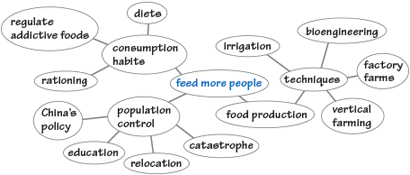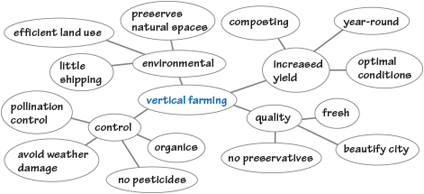Image map: A Periodic Table of Visualization Methods
Creative techniques can help you generate ideas as well as remember them later.
Brainstorming is the process of rapidly listing as many ideas as you can about a topic or question. You can brainstorm on your own or in a group, but don’t judge the ideas. Just keep writing them in a cluster or a list until you can’t think of any more.
Question: How can we meet growing food demand?

Once you’ve finished the initial brainstorming, select one of the ideas and use it to start a new cluster. By repeating this process, you make deeper creative connections.

Your Turn Brainstorm ideas about a topic that your instructor supplies, or use this topic: How can we reduce bullying? Then choose one of your initial ideas and continue brainstorming to make creative connections and delve more deeply into the topic.
One way to remember an abstract concept or a difficult word is to create a visual version of it. To visualize a concept, follow these steps:
|
Your “radius” is the forearm bone that rotates. Your “ulna” is the forearm bone connected at the elbow. Your “humerus” is the large upper arm bone. |
|
Radius sounds like “radios.” Ulna sounds like “all know.” Humerus sounds like “humorous.” |
|
We “all know” the “humorous” D.J. on our “radios.” |
|  |
Visualization works for four reasons:
Your Turn Think of a difficult term or list of terms that you are dealing with in a class. Create a visualization for the term or terms, following the process above.
Image map: A Periodic Table of Visualization Methods
© 2014 Thoughtful Learning
